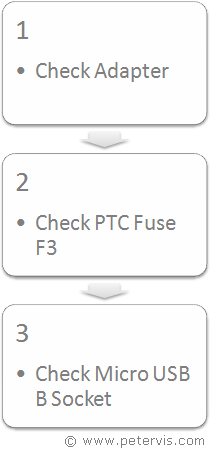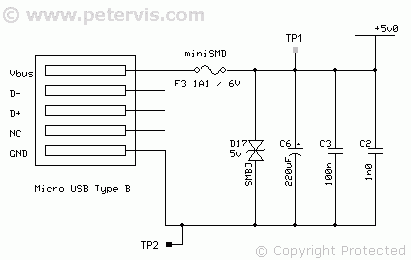Raspberry Pi Dead
A dead Raspberry Pi that does not switch ON or boot is always bad news for the pocket. Assuming that the board used to work, and perhaps it was dropped or improperly used that caused it to stop working you may have a job of figuring out whether it is recoverable. There is a power LED on the board, and if that does not light then you will need to diagnose the fault and repair it. This article shows some of the basic diagnostic steps required for isolating the fault.

If the power LED on the Raspberry Pi board does not light, the first thing to check is the power adapter. The quickest way to diagnose a faulty adapter is to use a known good adapter. Alternatively, use your adapter to see if it powers a known good Raspberry Pi board. If you are in a school environment and there are many adapters at hand, then this might be the quickest and simplest way, which will save time.
If you do not have access to any other adapters, then you will need to use a meter to measure the voltage level from the adapter.
If the adapter is working and you are sure of that fact, then the one obvious place to check is the SMD fuse on the Raspberry Pi. The following section of this article shows where the fuse is and how to check it.
Testing for Voltage

If you have verified that the adapter is working and providing the correct voltage, then the next step is to determine if this voltage is entering the board. It could be a damaged power socket; however, measurement of voltage with a meter is required to make that determination.
The designers of the Raspberry Pi board have provided two test points on the PCB, where you could check to see if there is any voltage entering the board. The schematic diagram above shows those two test points. They are located on the components side of the PCB as shown in the Raspberry PI Power Supply Minimum Voltage article.
As you can see from the circuit diagram of the power input section, the PCB trace connects directly from the Micro USB B socket to fuse F3.
With the black probe of your digital meter connected to TP2, check for +5 V at TP1 with the red probe. If there is +5 V there, then you need to look for a fault further down the line.
If there is no voltage at TP1, then check for a voltage on the other side of the fuse. The quickest way to do this is to locate the fuse F3 and check for a voltage on both of its terminals, with the black probe connected to ground.
If there is +5 V on one terminal of this fuse, however nothing on the other terminal, then the fuse requires replacement. If there is no voltage on either terminal, then look for damage to the Micro USB B socket, as this indicates that power is not entering the board.
Fuse F3: PTC
The Raspberry Pi fuse F3 is a Positive Temperature Coefficient (PTC) surface-mount device (SMD) component which has a rating of 1.1 A and 6 V. A PTC is a self-resetting fuse, which trips during over current situations, however, it resets automatically upon removal of the short, and the fuse allowed cooling time.
When there is a short circuit, a large amount of current passes through the fuse, which causes it to heat, resulting in an increase of its resistance. The increase in resistance has a current limiting effect, which protects the circuit from potentially large currents.
With a very heavy short of long duration, the operating characteristics of the fuse may change and remain fixed with a small resistance. In such an event, it is a good idea to remove the short, and replace the damaged fuse.
Dead RPi Boards on eBay
People often ask whether it is worth buying a dead board on eBay. Many people usually sell their faulty boards when they stop working and eBay is the top place to find such boards. They can be sold cheaply and people are often tempted to buy one to repair. Considering those hobbyists may have read this very same article and figured out that it is not the fuse or anything simple that has failed, it may not be worth buying a faulty board.
Many other things could fail on the board, and it could be the Broadcom BCM2835 processor, which has given up. On the other hand, it could be the memory chip, open burnt traces, and even damaged voltage regulators. Therefore, unless you are highly experienced and competent with specialist equipment to replace the processors and surface-mount devices, it is not usually worth buying a dead board.
This Article Continues...
Raspberry Pi DeadRaspberry Pi Fuse
European Fuse Markings